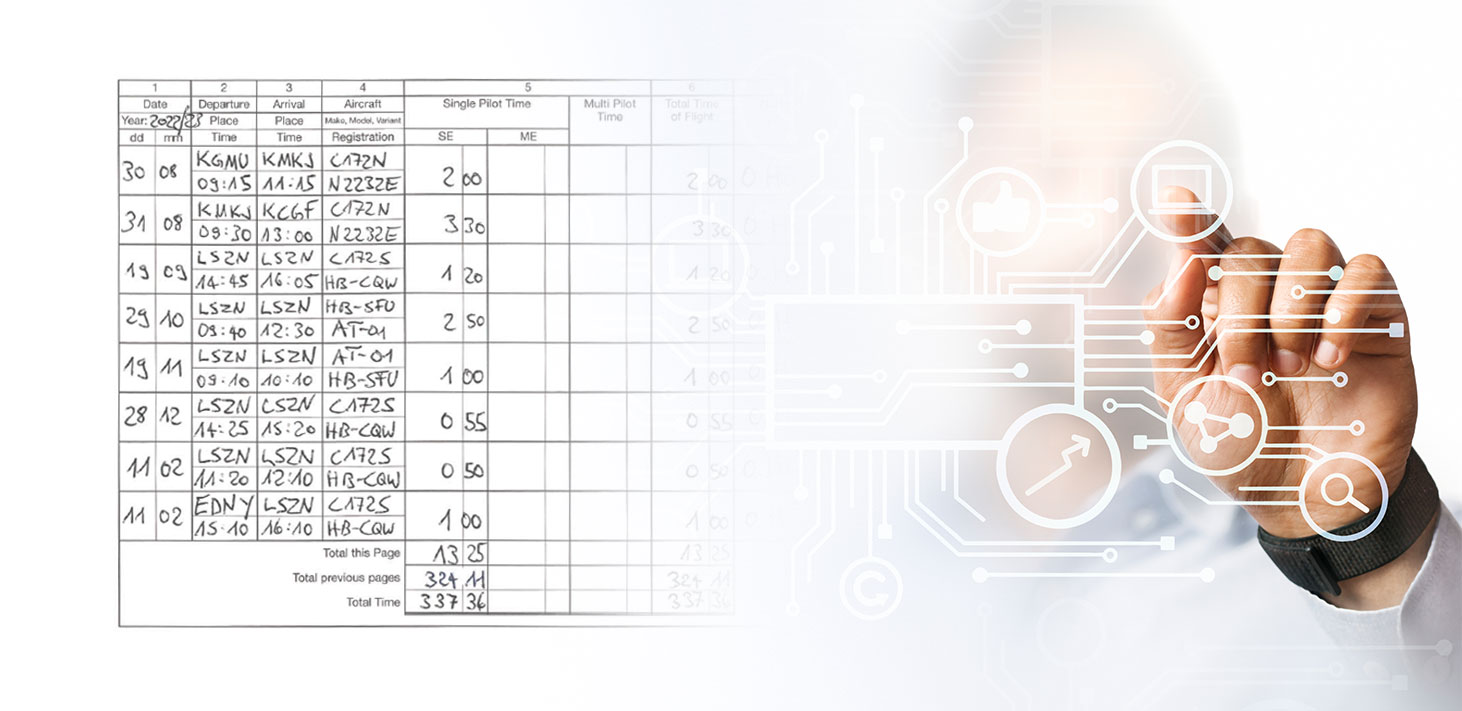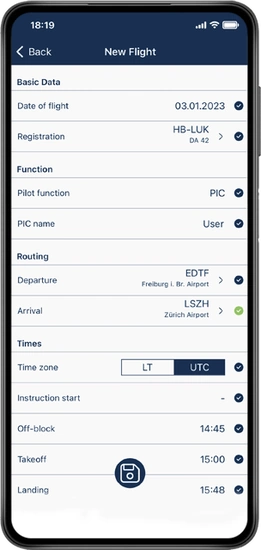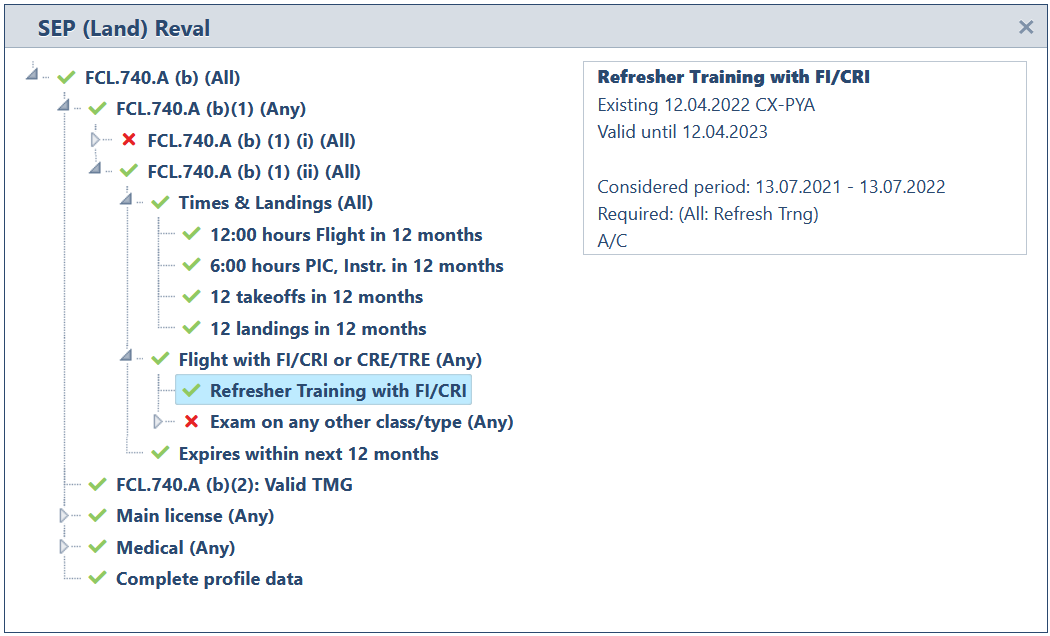Requirements for digital pilot logbooks
Digital logbook requirements
In addition to the general requirements, there are requirements specific to digital logbooks.
In contrast to the general requirements, there are still many uncertainties when it comes to electronic logbooks for pilots. Although initial efforts are already being made to establish good guard rails, many authorities are still drifting along rather disorientated.
These concern the acceptance of digital records, the security of data, the protection of privacy, but also the integrity of signatures and information.
In the following sections, we explain what basic principles already exist and what pilots can use as a guide if they want to benefit from the advantages of the digital world while complying with regulatory requirements as comprehensively as possible.

Amendment 9 to the rescue (or not)
On March 19, 2020, electronic recordings were introduced into the EASA regulations. By means of AMC & GM to Part-FCL - Issue 1, Amendment 9, the "electronic format" was generally permitted. At the same time, however, the responsibility for the precise drafting of guidelines is deferred to the Competent Authorities of the Member States.
An exception was already formulated in AMC1 FCL.050 (c) (1) before 2020 for flights within the scope of commercial air transport, namely that the operator has the option of taking over the duty of flight recording from the pilots and may use a computerized format. You can learn more about the compliance for operators, airlines and their pilots.
"In case of electronic records": AMC1 FCL.050 (e) (2)
Of particular interest is the formulation of paragraph AMC1 FCL.050 (e) (2), which represents a first, somewhat unwieldy step by EASA towards digital tools.
AMC1 FCL.050 (e)
Flight crew logbook entries should be made as soon as practicable after any flight undertaken. All entries in the flight crew logbook should comply with the following:
(1) in case of paper records, they should be made in ink or indelible pencil; or
(2) in case of electronic records, they should be made and kept in a way to be readily available at the request of a competent authority, and contain all relevant items that are mentioned in (a), certified by the pilot, and in a format acceptable by the competent authority.
When reading this article, we make the following observations:
- The entries have to be in a format acceptable by the competent authority.
- The entries have to contain all relevant items according to FCL.050 (a).
- The entries have to be certified by the pilot.
- The entries have to be made and kept in a way readily available at the request of a competent authority. Interestingly - and probably not intended by the rule makers - this requirement is only listed for electronic records.
In general, it is a welcome step for electronic records to be explicitly mentioned as a legitimate method of record keeping.
However, this wording can be interpreted in completely different ways as long as the Competent Authority does not provide its own guidance materials and information (GM/Info) defining the acceptable format.
The absence of a GM/Info could mean that no acceptable format exists and therefore no electronic formats are permitted. But it can just as easily be interpreted to mean that the authority accepts any digital form without further restricting it in any way.
This uncertainty characterizes everyday flying and is troublesome for pilots, flight schools and companies.

We are monitoring the situation in various countries and are making our information available on the following page:
Digital pilot logbook acceptance per countryLegal certainty helps everyone involved and leads to innovation
The authorities' hesitation is understandable because they often lack the resources and personnel to develop good regulations for challenging technical issues.
At the same time, this absence often prevents the actual, high-quality digitization of workflows and thus the reduction of bureaucracy and unproductive remnants from an old era.
As long as there are no good directives, pilots are not protected from defective, low-quality products and possible grave legal consequences.
In the following sections, we summarize the most important factors from a pilots' perspective that, in our opinion, must be taken into account when the authorities develop regulations for digital logbooks.
Data Safety - Protection against destruction
A paper book can be lost, stolen or destroyed, resulting in its permanent loss. Even if you have scans of it, the integrity of the handwritten signatures, for example, is lost forever.
Digital data can also be destroyed, but the risks and possible causes are different. With certain providers, the loss of a smartphone can lead to the loss of all data. Another risk is so-called ransomware, which encrypts the data and makes it unusable. It is also possible that a provider may go bankrupt.
An important requirement that remains invisible most of the time, but becomes painfully apparent in the event of an incident, is a serious backup policy as well as regular security updates and maintenance of all components used, such as code frameworks and technologies. In addition, mirroring the data to multiple devices, such as a central server and the pilot's mobile devices, can provide additional confidence in the safety of the data.
Data Security - No unauthorized access
The personal pilot logbook contains personal data of the pilot, instructors and examiners, but also information that is central to flight safety. Particularly when you think of the working and rest time regulations, certain data records could provide some media fuel shall they become public.
Fortunately, awareness of data protection and privacy has increased significantly in the recent years. The GDPR and supplementary national legislation are increasingly setting specific requirements, which of course also apply to digital pilot logbook providers.
As part of license requests or ramp checks, certain data must sometimes be submitted to the authorities or employers. However, they should not have unrestricted access to the data, but only be allowed to view it in a manner defined by law and in the pilot's control.
Data Sovereignty - Control over your data
Flight related data is often shared with maintenance, accounting, reservation and training stand systems.
But the data in your personal logbook belongs solely to you, the (aspiring) pilot license holder.
There are sometimes providers of software solutions used by flight schools, clubs and companies that offer a “personal flight logbook” as a functionality. Although this may seem tempting at first glance, there is usually a high level of dependency on the employer, flight school, club or navigation software.
It is extremely annoying if access to data is no longer fully guaranteed due to the termination of a membership or employment relationship. You should also bear this in mind if you use a subscription to navigation apps which you might want to replace in the future.
That is why it is important that you have your own, independent data collection that you have complete control of and can take with you at any time.
Data Integrity - No unnoticed changes to the data
Ensuring the integrity of data is essential in order to be able to present a credible, serious and reliable personal flight logbook.
There is a healthy mistrust among the authorities because there are always a few people trying to gain an unfair advantage. While unnoticedly changing times and landings in a paper logbook is rather tedious because you have to work with a corrector (which is forbidden), it is very easy with a digital format which does not have specific features to handle this case. A sensible requirement for digital flight logbooks therefore includes mechanisms that ensure traceability.
The signing of flight entries by instructors, examiners and flight schools is a fundamental part of every logbook to ensure the safety in aviation. There are various formats of digital signatures that can be used but it is important that once signed, the data can no longer be changed. If this is not fundamentally guaranteed, signatures are worthless. This requirement protects both the integrity of the signatory and that of my personal logbook as a reliable record of flight experience and training.
Regulatory compliance - Official document of proof
While the previous four points apply to IT systems in general, this section is for the very specific requirements for the personal logbook, which is an official document (keyword: forgery of documents).
Here, we are talking not just about collecting data, but also about what data is collected and how this is done.
The data collection should meet the requirements of the digital flight logbook as an official document of proof. The data should be recorded in such a way that all necessary values are included, are digitally verified for plausibility and can be evaluated.
This includes requirements for the typing of values so that they can be calculated correctly and that these calculations are actually carried out electronically. Values such as the off- and on-block times must be correctly typed and stored as dates and times, and the flight time calculated accordingly.

Another important component of this is clear semantics, or in other words the preservation of evaluability. As soon as users can introduce their own columns for license, endorsement or privileges relevant data, the digital evaluability of the data generally ceases. capzlog.aero has developed the concept of Flight Markers for this purpose.
A fundamental factor that is given too little consideration in the digital landscape is the completeness of data. It is very tempting not to enter information or to enter it only partially, e.g. leaving out the aircraft registration, unless the digital tool explicitly requires it.
The greatest art, however, is ensuring correct flight data. To this end, both the regulatory significance and the practical relevance and the evaluations based on these values must be precisely understood. The simplest example is that the time of landing cannot be before the time of take-off. A more complex example is that a TRI on the jump seat during a line check may record instructor time but not PIC time.
Another very good example is the correct recording of series of flights. The automatically calculated values for flight time such as block time or rotor turning time must not be editable by the user, with the exceptions provided for in AMC1 FCL.050 (series of flights; augmented crew; relief pilot; etc.).
Interests of the authorities towards electronic licenses and digital workflows
Every modern authority should realise that high-quality regulation leads to high-quality data, which is a necessary prerequisite for the highly automated digital evaluation of license requests, which on its own is a prerequisite for process and resource optimization.
Proof of concept in Switzerland
In Switzerland, the FOCA was the first Competent Authority ever to issue an official directive that describes the above-mentioned requirements in detail and thus creates clarity.
The clear legal situation has also led to many further digitalisation steps at flight schools, operators and airlines, which now have a positive impact on productivity, safety and cooperation between the parties.
The requirements for the revalidation of the SEP (Land) Class Rating, which is due every two years, can be monitored and the revalidation request can be generated by the user with one click in capzlog.aero and sent directly to the authority.

This not only saves an enormous amount of bureaucracy and effort, but also increases flight safety because all calculations and validations are carried out automatically by certified software components. The need for manual verification is a tedious memory of the past.
What is to be expected for the next years?
Things are slowly starting to move because more and more authorities start realising that they are in danger of falling behind and burying their employees in long-lasting tasks and processes. At the same time, the experience gained in Switzerland is having a positive impact, as the advantages have been clearly identified and already benefit all stakeholders.
We assume that more and more authorities will develop and provide corresponding guidance. We actively encourage them to do so and are happy to offer our practical experience.
Ultimately, however, it is the pressure of the pilots that will make the difference. If there are repeated requests, if the decision-makers realise that the pilots are demanding and advancing their interests, this will have a positive effect.
Frequently Asked Questions
Do you have any questions about capzlog.aero and its functionalities?
Ask our support teamWhich is the best digital logbook?
Apart from capzlog.aero, there are still no digital pilot logbooks that fulfil all existing requirements and are officially audited. However, there are some that already offer certain functionalities such as statistics or analyses that we have not yet developed.